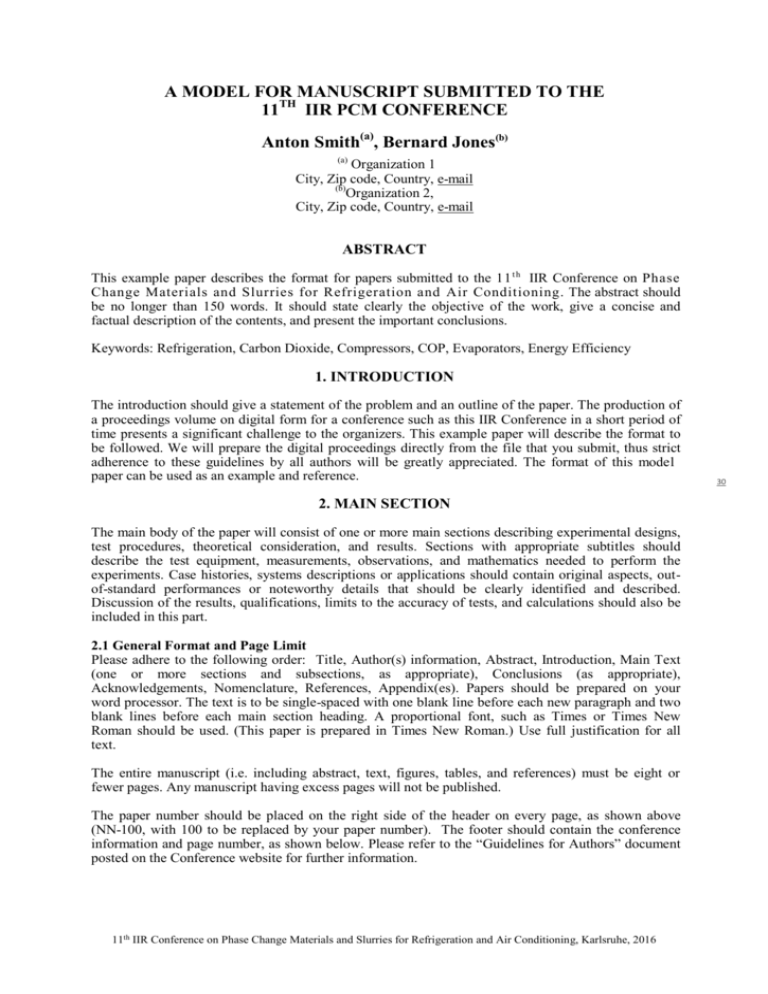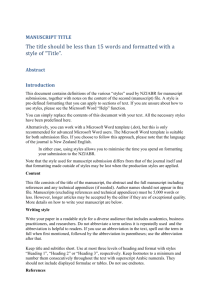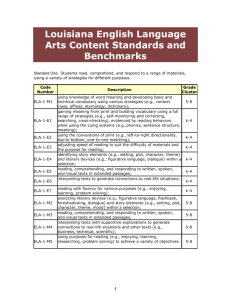a model for manuscript submitted to the 11
advertisement

A MODEL FOR MANUSCRIPT SUBMITTED TO THE 11TH IIR PCM CONFERENCE Anton Smith(a), Bernard Jones(b) (a) Organization 1 City, Zip code, Country, e-mail (b) Organization 2, City, Zip code, Country, e-mail ABSTRACT This example paper describes the format for papers submitted to the 11 t h IIR Conference on Phase Change Materials and Slurries for Refrigeration and Air Conditioning. The abstract should be no longer than 150 words. It should state clearly the objective of the work, give a concise and factual description of the contents, and present the important conclusions. Keywords: Refrigeration, Carbon Dioxide, Compressors, COP, Evaporators, Energy Efficiency 1. INTRODUCTION The introduction should give a statement of the problem and an outline of the paper. The production of a proceedings volume on digital form for a conference such as this IIR Conference in a short period of time presents a significant challenge to the organizers. This example paper will describe the format to be followed. We will prepare the digital proceedings directly from the file that you submit, thus strict adherence to these guidelines by all authors will be greatly appreciated. The format of this model paper can be used as an example and reference. 2. MAIN SECTION The main body of the paper will consist of one or more main sections describing experimental designs, test procedures, theoretical consideration, and results. Sections with appropriate subtitles should describe the test equipment, measurements, observations, and mathematics needed to perform the experiments. Case histories, systems descriptions or applications should contain original aspects, outof-standard performances or noteworthy details that should be clearly identified and described. Discussion of the results, qualifications, limits to the accuracy of tests, and calculations should also be included in this part. 2.1 General Format and Page Limit Please adhere to the following order: Title, Author(s) information, Abstract, Introduction, Main Text (one or more sections and subsections, as appropriate), Conclusions (as appropriate), Acknowledgements, Nomenclature, References, Appendix(es). Papers should be prepared on your word processor. The text is to be single-spaced with one blank line before each new paragraph and two blank lines before each main section heading. A proportional font, such as Times or Times New Roman should be used. (This paper is prepared in Times New Roman.) Use full justification for all text. The entire manuscript (i.e. including abstract, text, figures, tables, and references) must be eight or fewer pages. Any manuscript having excess pages will not be published. The paper number should be placed on the right side of the header on every page, as shown above (NN-100, with 100 to be replaced by your paper number). The footer should contain the conference information and page number, as shown below. Please refer to the “Guidelines for Authors” document posted on the Conference website for further information. 11th IIR Conference on Phase Change Materials and Slurries for Refrigeration and Air Conditioning, Karlsruhe, 2016 30 2.2 Margins The text area is to be 17.0 cm wide by 25.2 cm high. Table 1 presents the margin settings for A4 size paper. It is important to adhere to these margins to ensure that your manuscript prints properly on the paper format from the Conference Proceedings. Table 1. Page margins for manuscripts submitted to the Nth IIR Conference Margin Position Top Bottom Left Right A4 margin size 2.00 cm 2.50 cm 2.00 cm 2.00 cm 2.3 References Bibliographical sources should be cited by giving the last name(s) of the author(s) and the year of publication. The year should always be in parentheses, whether or not the name of the author(s) is. The citations for Herbe and Lundqvist (1997) and Pearson (1996) provide examples for the format for a journal article and conference proceeding, respectively. In the case of a source with three or more authors (e.g. Hirschfelder et al., 1967), which also provides an example citation for a book, only the name of the first author is cited in the text, but all authors are listed in the entry in the References section. The References section should be alphabetized by the last name of the first author. 2.4 Tables and Figures Each table should be numbered (Table 1, Table 2, etc.), with the caption being placed above the table. Each figure should be numbered (Figure 1, Figure 2, etc.), with the caption being placed below the figure. In the text, figures and tables should be referred to as follows: “Fig. 1 shows the relationship …” or “the measured values are given in Table 1.” Figures and tables should be inserted into the text soon after they are first referenced (as illustrated by Table 1). 2.5 Equations and Symbols Use the “Equation Editor” whenever possible. Equations should be centered, with the equation number flush with the right margin. If you are using the “IIR equation” style, this is accomplished by inserting tab characters before the equation and before the equation number. Equations should be cited in the text with its number, for example, “…as shown in Eq. (1)”. Equations should be separated from the text above and below by a blank line. Symbols used in equations should be explained directly within the paragraph they first appear or in a nomenclature section at the end of the manuscript. Symbols for physical quantities should be italicized. Exceptions are symbols for established dimensionless groups (e.g. Reynolds Number Re), which should not be italicized. An example equation would be the ideal gas law pV RT (1) where p is pressure in kPa, T is temperature in K, V is molar volume in molL–1, and R is the gas constant. If few equations are used, the definition of symbols may follow each equation. Otherwise the manuscript shall include a Nomenclature where all symbols and abbreviations are explained. Use the international system of units (SI). Avoid use of the solidus (/) but present quantities in the denominator always with negative exponents. A separate nomenclature section should be used when equations are used extensively. The units used should be given, if appropriate. For the Nomenclature section only, a two-column format may be used, if desired, to save space. 2.6 Use of “Styles” in Word The conference organizers are encouraged to prepare a template of a manuscript with the ‘styles’ features in Microsoft Word. The following explanation may be provided to explain the use of the template. We have prepared this manuscript using the “styles” feature in Microsoft Word. Styles are a very powerful tool that can greatly simplify the formatting of a manuscript, but we find that many authors are unfamiliar with their use. The basic idea is to define a “style” for each element in the paper—title, author list, section headings, text paragraphs, equations, references, etc. When preparing 11th IIR Conference on Phase Change Materials and Slurries for Refrigeration and Air Conditioning, Karlsruhe, 2016 31 the manuscript the author simply types (or pastes in from other sources) the appropriate words. Then, at the end, the vast majority of the formatting effort is accomplished by simply applying the appropriate “style” to the various elements. Alternately, the author can open this document in Word and replace the elements of this paper with his or her own material. For example, place your cursor over our names in the author list and type your name(s). The appearance and location of the “Styles Formatting Palette” or “Styles Window” will vary depending on the version of Word that you are using. You may also need to “Show the Styles Window” and select “Show styles in use.” All of the styles defined in this paper start with “IIR_” followed by a descriptive word or two, such as “IIR_TITLE.” A number of other standard styles, defined by Word itself, may also appear. Refer to the topic “About formatting text by using styles” under the Help menu for more information on using styles. 3. CONCLUSIONS The Conclusions section should list the major conclusions of the work and summarize the significance of the paper as clearly and concisely as possible. ACKNOWLEDGEMENTS A short section may acknowledge special assistance, such as financial aid, help of guiding technical committees, individuals, or other groups. NOMENCLATURE p pressure (kPa) T temperature (K) R V molar gas constant (8.314472 Jmol–1K–1) molar volume (molL–1) REFERENCES Duminil, M., 1995. Principes de la production du froid. In: Côme D, Ulrich. R. La chaîne du froid – Le froid au service de l'homme, Hermann, Paris: 33-144. Herbe, L., Lundqvist, P., 1997. CFC and HCFC refrigerants retrofits. Int. J. Refrigeration 20(1), 49-54. Hirschfelder, J.O., Curtiss, C.F., Bird, R.B., 1967. Molecular Theory of Gases and Liquids. John Wiley and Sons, Inc., New York. Pearson, S.F., 1996. Uses of Hydrocarbon Refrigerants. Proceedings of the IIR Conference of Application for Natural Refrigerants, Aarhus, Denmark, IIF/IIR, 439-446. 11th IIR Conference on Phase Change Materials and Slurries for Refrigeration and Air Conditioning, Karlsruhe, 2016 32








